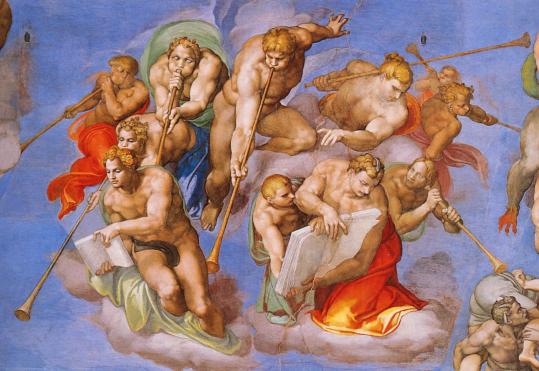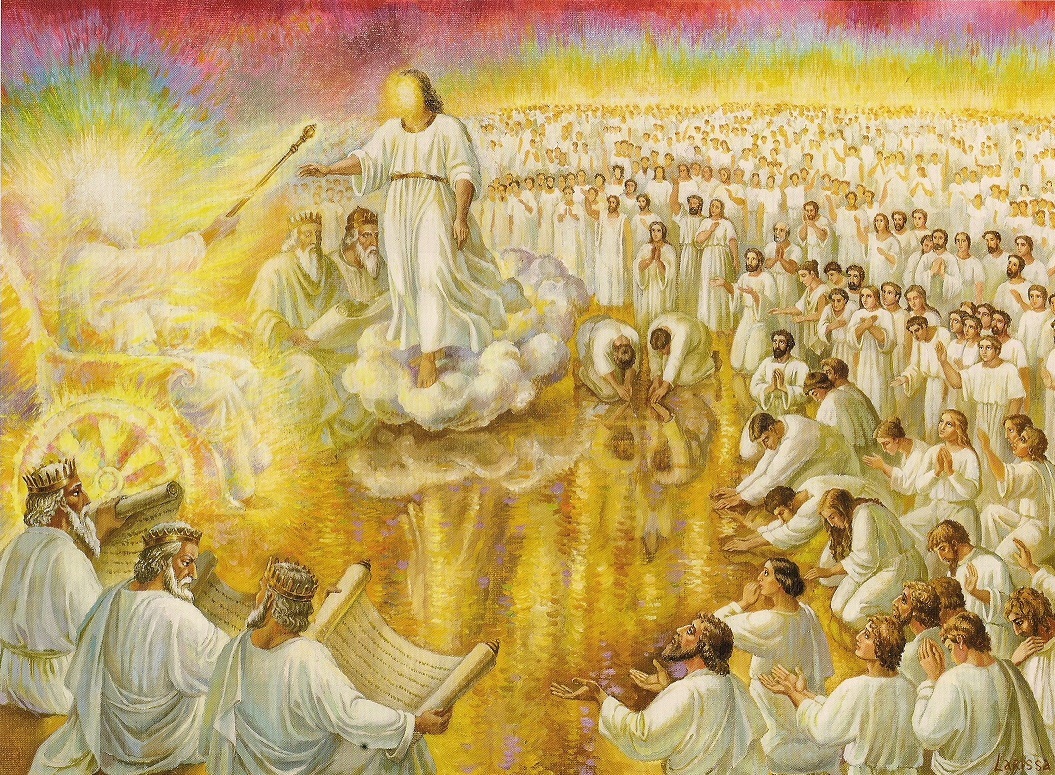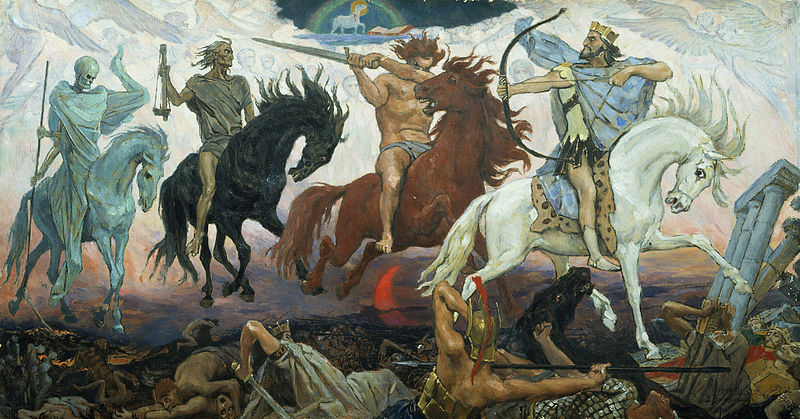As a singer and former musician (trumpet/piano), I can appreciate
all that goes into a good performance. The personal practice hours, multiple
rehearsals, and run-throughs all contribute to the concert that the audience observes.
Often the occasion of the concert would directly impact the way that we would prepare/warm
up. If it was a competition, run-throughs and rehearsals took a serious and
focused tone. Pep rallies and parades were more informal in both execution and
preparation. That said, in the days, hours, and even moments before the down
beat of the first note of the first measure of the first song, the band/orchestra
was busy with activity.

The same is true in our passage today. As we reenter the
unfolding process of judgment being executed in Revelation, we come to
Revelation 8 and the breaking of the seventh seal. Unlike any seal before it,
what commences as a result of the opening of this scroll can best be described
as a cosmic concert warm-up—final preparations before God strikes the downbeat
and the angels blow their (in this case) trumpets. Let’s watch the final
preparatory activities that are executed in Revelation 8:1-6 and come to
appreciate how God is able and willing to respond to the prayers of his people.
a. A Deep Breath is
Taken-8:1-“…When the Lamb broke the seventh seal, there was silence in
heaven for about half an hour,…”
The sequence that was briefly interrupted in chapter 7
(following the breaking of the sixth seal), returns in verse 1 of chapter 8
with the identification of the seventh seal—“When the Lamb broke the seventh
seal,…”. The parity between this opening phrase and the introduction of the
first six seals demonstrates that John is now reverting back to the same
program he began all the way in chapter 6 (the dramatic process of opening the
title deed to the universe and ushering in the judgments against the world in
an effort to bring about a new one). This final seal is different from the
preceding six for several reasons. First, unlike the previous six, this is the
last barrier keeping the contents of the scroll hidden. No longer will God’s great
wrath be withheld and no longer will the eschatological events necessary to
bring about a new heaven and a new earth be left a mystery. Second, upon
breaking the seventh seal, something unexpected happens. Instead of the
emergence of a rider on a horse or a cosmic event brought about by an angelic
being or natural disaster, “there was silence in heaven for about half and
hour” (8:1). At least 8 different interpretations of this period of silence
have been offered. As they are not mutually exclusive (Osborne, Revelation, 337), it is worth providing
a compendium of the interpretive options here:
1. Silence allowed the prayers of the saints to be heard
(see 8:3-5; Caird; Bacukham)
2. Silence marked a temporary cessation of revelation given
to John (Swete)
3. Silence highlights a dramatic pause that telegraphs the
dread to come in the sounding of the trumpets and pouring of the bowls
(Beckwith, Mounce, Thomas, Giesen).
4. Silence alludes to the pre-creation void in which God
spoke to bring the universe into existence. This allusion is appropriate here
as now God is recreating the heavens and the earth (Rissi, Soloff, Sweet).
5. Silence helps accentuate the completion of the seven seal
visions
6. Silence is in keeping with ancient liturgical practices
in which a hush precluded prayer (Malina, Aune).
7. Silence here is the silence of the condemned from the
sixth seal as they await divine judgment (Prigent; Beale; see also Isa. 47:5;
Amos 8:2-3)
8. Silence highlights an intense expectation of God’s
involvement as now another cycle of judgment begins.
(List adapted from Osborne, Revelation, 336-37).
As it is quite possible that more than one of these
connotations is in play, Hindson’s designation of this silence as a “holy hush”
is uniquely fitting. After all, the silence is in the holy presence of God and
what follows is a dramatic display of his holiness realized in judging a wicked
world. In many ways, this silence is a deep breath, both for the reader and for
heaven itself, taken prior to the cacophony that would soon ensue on the
world’s stage.
Scary movies often employ silence to increase the heart rate
and sense of dreadful expectation of those in the audience. In fact, the only thing worse in a scary movie
than the scary music is no music at all and the threat of something popping out
and scaring you. We shift in our seats and even cover our ears in awful
anticipation. I believe that this is similar to what is going on here. Heaven
is silent, letting all in heaven and on earth know that something big is on its
way (see Exod. 14:14; 1 Sam. 12:16; Isa. 41:1; Hab. 2:20; Zeph. 1:7; Zech.
2:13).
b. The Instruments
are Handed Out-8:2-“…And I saw the seven angels who stand before God, and
seven trumpets were given to them,…”
The deafening silence is interrupted by the distribution of
trumpets—“And I saw the seven angels who stand before God, and seven trumpets
were given to them” (8:2). As familiar as trumpets are to today’s reader, these
were even more commonplace in the ancient Jewish world. Not only were trumpets
used in times of war (Josh. 6:20; 1 Sam. 13:3; Jer. 51:27) they were also used
in and around the temple. In fact, trumpets would be heard no less than 21
times from the temple complex on a typical day in ancient Jerusalem. On special
days (feasts, etc.), they would be heard as many as 48 times. Trumpets were
blown to celebrate a dedication (2 Chron. 5:12; Neh. 12:41), at the
enthronement ceremonies of kings (1 Kings 1:34, 39), and even to call the
nation to repentance (Isa. 58:1; Jer. 4:5). Finally, trumpets introduced the
presence of God either as witnessed with the ark in 1 Sam. 6:15 or on Mt. Sinai
in Exod. 19:16. Generally speaking, when a trumpet sounded, God was up to
something important and this will prove to be the case in the remainder of Revelation.
As a trumpet player in high school and college I remember
how loud we proved to be as a section both in concert and marching band. In
fact, more than any other section (flutes, French horns, baritones, clarinets,
etc.), the trumpets had to be told on multiple occasions to back off. There is
something about the instrument (and probably those who play it) that lends the
trumpet to being one of the loudest instruments available. Fewer things were
more rewarding as a trumpet player to be given permission to really let it rip
and blow the audience away with the music we were given. Similarly, though we
don’t hear the trumpets now, as readers we can rest assured that we are about
to be blown away by what happens next.
It is important to once again point out that as with the
first few seals, the authority of both the positive or negative players in the
unfolding saga is given/bestowed to them. Like the horsemen in chapter 6
(particularly verses 2, 4, and 8), these angels are given the authority to
sound forth the judgments to come by a more powerful being—God himself—who does
so in response to the Lamb who alone is worthy to break this final seal.
c. The Prayers are
Collected-8:3-4
While the angels (now heralds) are warming up their
instruments in the background more preparation is shown to be underway as “Another
angel came and stood at the altar, holding a golden censer, and much incense
was given to him, so that he might add it to the prayers of all the saints on
the golden altar which was before the throne,…” (8:3). This angel appears to be
conducting the duties that priests of the Old Testament performed in the
earthly temple of lighting incense before the altar as a demonstration of
prayers lifted up God. A “censer” was an open-topped pan made of bronze used to
carry live coals from the altar of burnt offering for making sacrifices. The
prayers of God’s people are symbolized in the fragrant aroma that would emanate
from the burning fragrance. This is complicit with the use of the censer in the
Old Testament as often incense would be placed on the coals in the censers and
offered before the Lord (Numbers 16:6-7).
2 Chron. 13:11a-“Every morning and evening they burn
to the LORD burnt offerings and fragrant incense,”
Psalm 141:2-“May my prayer be counted as incense
before You; the lifting up of my hands as the evening offering”
Already in Revelation the prayers of the saints were
described as incense offered up to the Lord.
Revelation 5:8-“When he had taken the book, the four
living creatures and the twenty-four elders fell down before the Lamb, each one
holding a harp and golden bowls full of incense, which are the prayers of the
saints.”
One petition/prayer was described in detail in the fifth
seal “When the Lamb broke the fifth seal, I say underneath the altar the souls
of those who had been slain…” (Rev. 6:9ff). Therefore, what appears to be
taking place in chapter 8 is a grand collection of prayers. Added to the
prayers of the elders in chapter 5 and the prayers of the martyrs in chapter 6
are the prayers represented here in the incense contained in the golden censer
this angel is carrying—prayers that will soon be answered in no uncertain
terms.
Once collected, these prayers are sent directly before God
the Father—“And the smoke of the incense, with the prayers of the saints, went
up before God out of the angel’s hand” (8:4). With the amount of incense and
prayers that have already been described in this book, one can almost imagine
at this point the heavenly throng room willing with fragrant haze and smoke.
Something has to give, and it finally does in the next action that is taken.
d. The Gauntlet is
Thrown Down-8:5-“…Then the angel took the censer and filled it with the
fire of the altar, and threw it to the earth; and there followed peals of
thunder and sounds and flashes of lightning and an earthquake,…”
God in heaven responds to the prayers offered in the fifth
action that takes place—"Then the angel took the censer and filled it with
the first of the altar, and threw it to the earth; and there followed peals of
thunder and sounds and flashes of lightning and an earthquake” (8:5). It is a
dramatic answer to prayer that precludes the wrath that God will leverage upon
an evil planet as he seeks vengeance for the harm done to his cause and his
people. Earlier the coal from the offering was used to send prayers to God in
heaven, now, in response to those prayers, the angel returns to the same fire
to retrieve coals that are then thrown down to the earth as fire of
judgment.
Interestingly, this episode of the gauntlet being thrown
down suffers many parallels with Ezekiel 10:2-7. There, an angel is instructed
to retrieve coals in his hands from the throne and scatter them onto the city,
indicating fiery judgment. Some connect this Old Testament reference to the
sealing the righteous on their foreheads in Ezekiel 9:4 and with judgment of
the wicked in Ezekiel 1:12-13 (see also 9:4-6) (Bauckham, The Climax of Prophecy, 82). This Old Testament background is
appropriate given not only the context here in Revelation 8, but also the
sealing of the 144000 in Revelation 7 and those who will be judged moving
forward (in Revelation 8ff).
The rumblings of judgment are punctuated by the “peals of
thunder and sounds and flashes of lightning and an earthquake” (8:5). This is
what is referred to as a storm theophany in which God demonstrates something
about himself through natural phenomena. Here, he reveals his righteous
indignation and holy judgment by an appropriate cacophony of powerful sights
and sounds. “The major thrust is that the fiery judgments that are to ensue in
the following chapters are God’s response to the cries of his people and his
vindication of his followers for all that they have suffered” (Osborne, Revelation, 346-47). The prayers and
petitions of God’s people have been sent up as a burnt offering of incense to
the Lord. This has lit a fire of wrath in the heart of God. Now, fire will rain
down upon a guilty world system. What began as a largely Levitical expression
of prayer and supplication in verses 1-4 now turns apocalyptic as heaven break
through and throws down fire upon the earth.
e. The Angels Prepare
their Embouchure-8:6-“…And the seven angels who had the seven trumpets
prepared themselves to sound them,…”
The final preparatory activity in this passage involves the
setting of the embouchure of the trumpeting heralds—“and the seven angels who
had the seven trumpets prepared themselves to sound them,…” (8:6).
Embouchure refers to the shape one’s mouth takes when
playing an instrument with a mouthpiece (like a trumpet). The tightening of the
lips and the flexing of other muscles is employed even before air is sent into
the horn, in order to make a pretty sound. Such instinctive habits take place
when the instrument is raised to the mount in preparation for play. All of this
adds to the heightened sense of expectancy that is revealed in this passage
(Mounce, Revelation, 177).
So What?
With the musicians in place, embouchures fixed, and occasion
set, nothing stands in the way for the next phase of God’s judgment as realized
and revealed in Revelation 8ff. However, before we hear the unmistakable sound
of trumpet fanfare and watch the destruction that results, let us appreciate
what this passage has taught us about the nature of God. First, God is in
control. After all, it is he who gives the angels their instruments and the
authority appertaining thereunto. Second, he is holy. It is his righteousness indignation
that demands the evils of the world be dealt with severely and this we will
witness in the coming weeks. However, third, he is responsive to the prayers of
his people. This passage demonstrates that God listens to acts as a result of
the intercession that is made by those who love and follow after him. Here, the
prayers are described as an overwhelming cloud crying out for vindication—vindication
that the petitioners are promised to receive. However, for what is it that you
are praying? For whom is it that you are praying? Though the answer may tarry,
make no mistake, God responds to the prayers of his people. The same God that
heard the cries of his people in Egypt and ultimately delivered them to the Promised
Land, the same God who hears the cries of the martyrs in the heavenly throne room
and provides them ultimate salvation and vindication, is the same God that we
call upon today. If nothing else, allow this cosmic concert warm-up to motivate
you toward prayer—praying often and without fail for he listens and he
responds.
If you are looking for things to pray, consider praying for
the lost who will receive the judgment described in this book, unless they
enter the family of God. After all, what will prove to be a magnificent concert
for God’s people will also prove to be a hellacious cacophony for those who don’t
belong to him.

